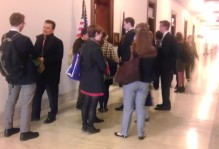Day 8 of 10: Sweatpants Saturday
January 10, 2015
As the title implies, we didn’t have to dress business casual-formal today. The simple freedom of knowing our pristine business clothes wouldn’t be drenched in sweat beneath layers of winter gear when we arrived at the office made the sun shine a little brighter and the snow a little whiter. Today was Drew Day. If that’s not a reason to celebrate, I don’t know what is.
There was a mini lecture about the five main types of teaching philosophies: perennialist, essentialist, progressivist, reconstructionist, and idiosyncratic. The personal teaching philosophy (PTP) influences the manner teachers teach, classroom practices, and states what a teacher believes about both teaching and learning. In a nutshell, this philosophy provides a basis for appropriate action and serves as a foundation for who you are (as a teacher) and what you believe in. The PTP contains how students should acquire knowledge, intellectual skills, and ideas/values in both method and content. Here are the five philosophies:
- Perennialist: emphasis on values.
- Rooted in realism (moral and religious training).
- Based on universal knowledge and cherished values of society.
- Curriculum based on subjects that have stood the test of time.
- Students’ minds are sponges designed to soak up knowledge from the unquestionable authority of teachers.
- Essentialist: emphasis on knowledge.
- More rooted in the contemporary scene than the past.
- Interested in conceptual thought, principles, and theories of subject matter.
- Education seen as mastery of essential facts and skills:
- English, math, science, history, and foreign language.
- Like perennialism, rejects art, music, physical education, homemaking, and vocational education.
- Teacher is seen as a master authority worthy of emulation.
- More rooted in the contemporary scene than the past.
The above mentioned are teacher centered styles of philosophies.
- Progressivist: emphasis on student experiences.
- Student-centered process where democracy and education go hand in hand.
- Interdisciplinary curriculum where learning includes content plus the skills of learning:
- Problem solving, scientific inquiry, cooperative-behaviors, self-regulation, etc.
- Memorization is de-emphasized.
- Teacher seen more as a guide than all-knowing sage.
- Reconstructionist: emphasis on societal reform.
- Society-centered education concentrated in social, economic, and political issues.
- Curriculum needs to be relevant and include elements of social issues:
- Pluralism, equality, and futurism.
- Teachers considered prime units of social and political change with students’ practice modeled after society.
- A similar style is existentialist where students own their own learning with a high emphasis on journaling and writing.
- Idiosyncratic: combination of all.
- A teacher will rarely cling to a single, identifiable teaching philosophy.
- Most teachers are somewhat eclectic in the formulation of their teaching philosophies.
After we learned some background and a brief quiz determined our education philosophy, Professor Drew split us into groups with representatives from each category. Our task was to create a school, which turned out to be easier said than done. In our debrief discussion a few questions were raised:
- How do schools address students in the middle? The ones who aren’t doing poorly, but also not excelling.
- When you (the school administrators) have limited resources, what do you add or get rid of?
- What draws teachers back in when they reach their breaking point? What sends them over the edge?
To commission Sweatpants Saturday, we watched a documentary about an alternative school called the Brooklyn Community Arts & Media (BCAM) High School. In this documentary we witnessed the inevitable collision that occurs when great brainstorming theories meet reality. BCAM went from soul train lines to leave school on Fridays to less than 40% of the first graduating class going on to college. One of the takeaways was teachers need to be equally open to learning like their students. A new teacher at BCAM had come from a higher class school and the transition into his new environment almost broke him. Rather than adjusting his teaching style to the needs of his new environment, he stubbornly maintained his old ways and grew increasingly disconnected from the students.
As we learned from a previous site visit, “you shouldn’t use your experience as universal”, which applies to all stakeholders in the education discussion. There’s a lack of character development from both sides of the spectrum. Paul Tough from NY Times pointed out in his article What if the Secret to Success Is Failure, character traits like grit, self-control, perseverance, social intelligence, and optimism determine whether or not an individual will succeed long-term in the real world and the world of academia. Failure and overcoming it using something within yourself is a crucial stepping stone in character development. But whether or not schools have the right to play a part in the students’ character development is a question for another time.
~ Lynelle Haugabrook




No comments.
Comments are currently closed. Comments are closed on all posts older than one year, and for those in our archive.